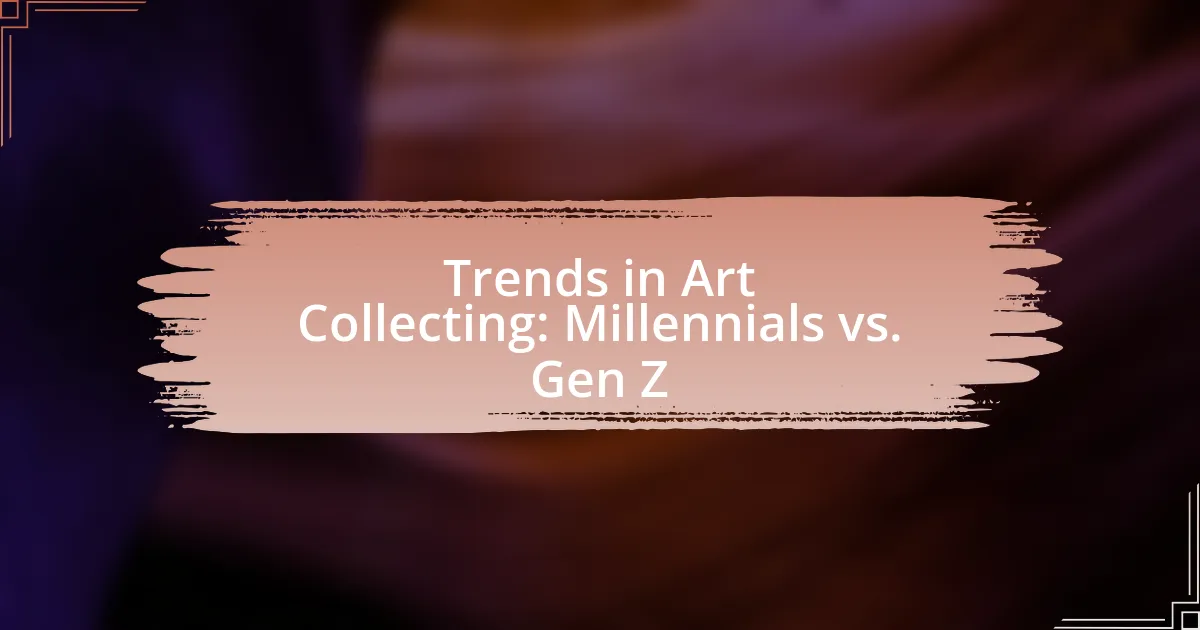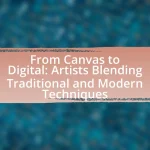The article examines current trends in art collecting among Millennials and Gen Z, highlighting their distinct preferences and motivations. Millennials tend to focus on investment and personal expression, often purchasing established artists’ works, while Gen Z emphasizes accessibility, social impact, and digital art forms like NFTs. Both generations utilize social media and online platforms for art discovery and acquisition, with Millennials prioritizing personal connections and investment potential, and Gen Z seeking authenticity and community engagement. The article also addresses the challenges these demographics face, including financial barriers and a lack of traditional art education, and offers insights into how they can adapt to the evolving art market.
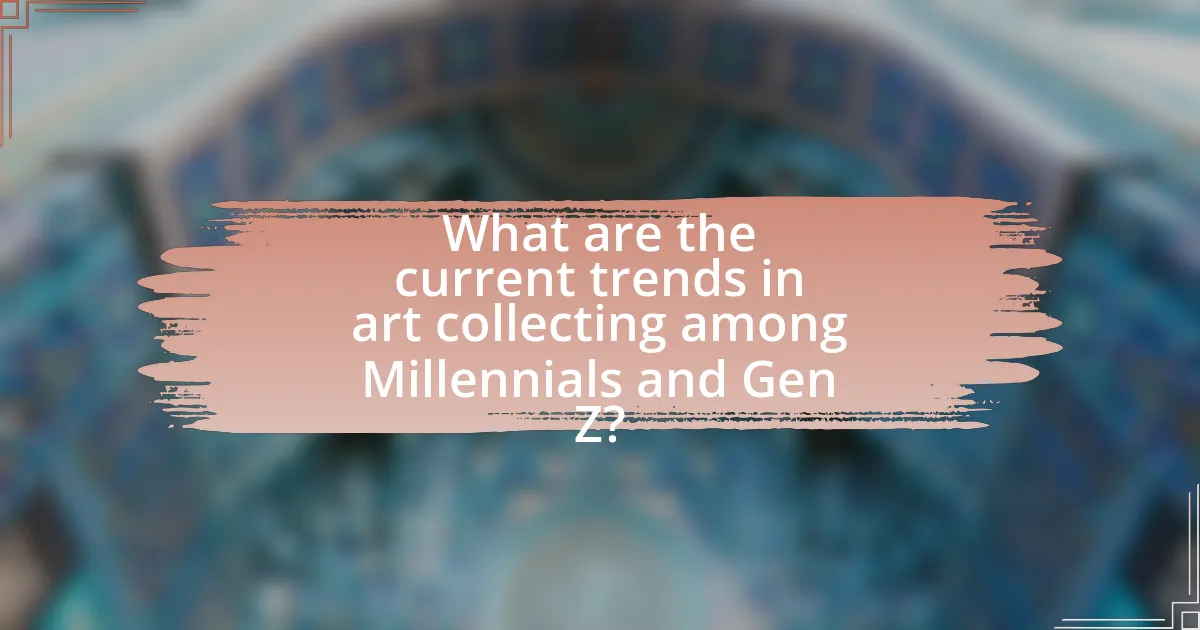
What are the current trends in art collecting among Millennials and Gen Z?
Current trends in art collecting among Millennials and Gen Z include a strong preference for digital art, particularly NFTs, and a focus on socially conscious and diverse artists. Millennials and Gen Z collectors are increasingly drawn to platforms like Instagram and online marketplaces for discovering and purchasing art, reflecting their digital-first approach. According to a 2021 report by Art Basel and UBS, 25% of Millennial and Gen Z collectors purchased art online, highlighting the shift towards digital transactions. Additionally, these generations prioritize artworks that resonate with their values, such as sustainability and representation, influencing their buying decisions.
How do Millennials approach art collecting compared to Gen Z?
Millennials approach art collecting with a focus on investment and personal expression, while Gen Z emphasizes accessibility and social impact. Millennials often seek established artists and view art as a financial asset, with 70% considering art a viable investment according to a 2021 Hiscox report. In contrast, Gen Z prioritizes emerging artists and digital platforms, valuing art that reflects social issues, as evidenced by their strong engagement with online marketplaces and social media for art discovery. This generational shift highlights differing motivations and methods in the art collecting landscape.
What factors influence Millennials’ art purchasing decisions?
Millennials’ art purchasing decisions are primarily influenced by personal connection to the artwork, social media trends, and investment potential. Personal connection drives Millennials to seek art that resonates with their identity and values, often leading them to support emerging artists. Social media platforms, particularly Instagram, play a significant role in shaping their preferences and exposing them to new art forms and artists. Additionally, Millennials consider art as an investment, with 70% viewing it as a way to diversify their portfolios, according to a 2021 report by Art Basel and UBS. These factors collectively shape their approach to art collecting.
How does Gen Z’s digital engagement shape their art collecting habits?
Gen Z’s digital engagement significantly influences their art collecting habits by facilitating access to diverse art forms and enabling community-driven platforms for discovery. This generation utilizes social media, online marketplaces, and digital galleries to explore and purchase art, leading to a preference for digital art and NFTs. According to a 2021 report by Art Basel and UBS, 25% of Gen Z collectors purchased art online, highlighting their comfort with digital transactions and virtual interactions. This trend reflects a shift from traditional art collecting methods, as Gen Z prioritizes authenticity, community, and the ability to connect with artists directly through digital channels.
What types of art are popular among Millennials and Gen Z?
Digital art and street art are particularly popular among Millennials and Gen Z. These generations are drawn to digital art due to its accessibility and the influence of social media platforms like Instagram and TikTok, where artists can showcase their work to a global audience. Street art resonates with them as it often conveys social and political messages, reflecting their values and concerns. According to a 2021 survey by Art Basel and UBS, 63% of young collectors prefer contemporary art, which includes these forms, highlighting their inclination towards innovative and expressive art styles.
Which art mediums are favored by Millennials?
Millennials favor digital art and photography as their preferred art mediums. This preference is driven by their familiarity with technology and social media, which facilitate the creation and sharing of digital artworks. According to a 2021 survey by Art Basel and UBS, 62% of Millennial collectors reported purchasing digital art, highlighting its growing significance in their art collection habits. Additionally, photography remains popular among Millennials, with many valuing its accessibility and ability to capture personal experiences.
What emerging art forms attract Gen Z collectors?
Emerging art forms that attract Gen Z collectors include digital art, particularly NFTs (non-fungible tokens), and immersive experiences such as virtual reality art installations. The rise of digital platforms has made it easier for Gen Z to access and collect art in these formats, with a significant portion of this demographic showing interest in owning unique digital assets. According to a 2021 report by Art Basel and UBS, 25% of Gen Z collectors have purchased NFTs, highlighting their growing influence in the art market. Additionally, immersive art experiences, which blend technology and traditional art forms, resonate with Gen Z’s preference for interactive and engaging content.
How do social media and technology impact art collecting trends?
Social media and technology significantly influence art collecting trends by enhancing accessibility and engagement for collectors. Platforms like Instagram and Pinterest allow collectors to discover and share art easily, leading to increased visibility for emerging artists and diverse art forms. According to a 2021 report by Hiscox, 63% of art buyers aged 18-34 use social media to discover new artists, highlighting the role of digital platforms in shaping preferences. Additionally, online marketplaces and virtual galleries have expanded the reach of art sales, enabling collectors to purchase works from global artists without geographical limitations. This shift towards digital engagement is particularly pronounced among Millennials and Gen Z, who prioritize authenticity and community in their collecting practices.
What role does Instagram play in Millennials’ art discovery?
Instagram serves as a primary platform for Millennials to discover art, significantly influencing their engagement with artists and artworks. The visual nature of Instagram allows users to easily browse and share diverse art forms, fostering a community where emerging artists can gain visibility. According to a 2021 survey by Art Basel and UBS, 70% of Millennials reported discovering new artists through social media, with Instagram being the most utilized platform for this purpose. This trend highlights Instagram’s role in democratizing art access and shaping contemporary art trends among Millennials.
How does Gen Z utilize online platforms for art acquisition?
Gen Z utilizes online platforms for art acquisition primarily through social media and digital marketplaces. This generation engages with platforms like Instagram, TikTok, and Etsy to discover and purchase art, often favoring direct interactions with artists and creators. According to a 2022 survey by Art Basel and UBS, 63% of Gen Z art buyers reported using social media to find art, highlighting their preference for visually-driven content and community engagement in the art acquisition process.
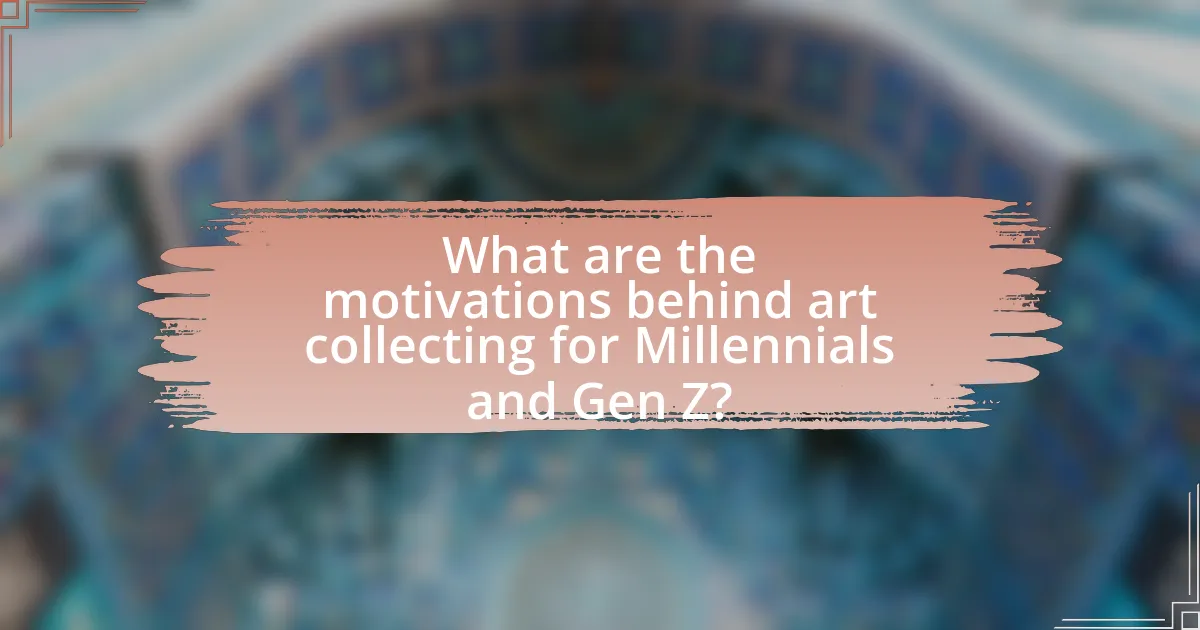
What are the motivations behind art collecting for Millennials and Gen Z?
Millennials and Gen Z are motivated to collect art primarily for personal expression and investment potential. These generations view art as a means to reflect their identity and values, often seeking pieces that resonate with their beliefs or cultural narratives. Additionally, the rise of digital platforms has made art more accessible, allowing them to discover and purchase works from emerging artists, which aligns with their preference for supporting independent creators. According to a 2021 report by Art Basel and UBS, 63% of Millennial and Gen Z collectors see art as a viable investment, indicating a strong interest in the financial aspects of art collecting. This dual motivation of personal connection and investment opportunity drives their engagement in the art market.
Why do Millennials invest in art?
Millennials invest in art primarily as a means of diversifying their investment portfolios and as a way to express personal identity. This generation views art not only as a financial asset but also as a cultural statement, often seeking pieces that resonate with their values and aesthetics. According to a 2021 report by Art Basel and UBS, 63% of Millennial collectors believe that art is a good investment, highlighting their inclination towards art as a financial strategy. Additionally, the rise of online platforms has made art more accessible, allowing Millennials to engage with the market more easily and to discover emerging artists that align with their interests.
What emotional connections do Millennials seek through art?
Millennials seek emotional connections through art that reflect personal identity, social issues, and shared experiences. This generation values authenticity and often gravitates towards art that resonates with their life narratives, such as pieces that address mental health, diversity, and environmental concerns. Research indicates that 72% of Millennials prefer art that tells a story or conveys a message, highlighting their desire for deeper engagement and meaning in their artistic choices. This trend underscores a shift towards art as a medium for personal expression and social commentary, aligning with their values and experiences.
How does art collecting serve as a status symbol for Millennials?
Art collecting serves as a status symbol for Millennials by reflecting their cultural capital and personal identity. This generation often views art as a means to showcase sophistication, taste, and individuality, distinguishing themselves in a competitive social landscape. According to a 2021 survey by Art Basel and UBS, 63% of Millennial collectors believe that owning art enhances their social status, indicating a strong correlation between art ownership and perceived prestige. Additionally, the rise of social media platforms allows Millennials to share their collections, further amplifying their status among peers and creating a visual narrative of success and cultural engagement.
What drives Gen Z to collect art?
Gen Z is driven to collect art primarily by a desire for self-expression and social connection. This generation values authenticity and seeks to curate personal identities through unique art pieces that resonate with their individual experiences and beliefs. According to a 2021 survey by Art Basel and UBS, 63% of Gen Z collectors view art as a means of self-expression, highlighting the importance of personal connection in their collecting habits. Additionally, the rise of digital platforms and social media has facilitated access to diverse art forms, enabling Gen Z to discover and support emerging artists, further motivating their engagement in art collecting.
How does Gen Z’s focus on sustainability influence their art choices?
Gen Z’s focus on sustainability significantly influences their art choices by prioritizing eco-friendly materials and practices in the artworks they support. This generation actively seeks out artists who use recycled or sustainable materials, reflecting their commitment to environmental responsibility. For instance, a survey by Art Basel and UBS in 2021 indicated that 70% of Gen Z collectors consider sustainability when purchasing art, showcasing a clear trend towards supporting artists who align with their values. Additionally, Gen Z often favors art that addresses social and environmental issues, further emphasizing their desire for meaningful and responsible consumption in the art world.
What social causes are important to Gen Z collectors?
Gen Z collectors prioritize social causes such as climate change, racial equality, mental health awareness, and LGBTQ+ rights. Research indicates that 76% of Gen Z individuals believe that brands should take a stand on social issues, reflecting their commitment to activism and social justice. This generation often seeks to support artists and organizations that align with their values, emphasizing the importance of ethical practices and sustainability in their collecting habits.
How do personal values shape the art collecting practices of both generations?
Personal values significantly influence the art collecting practices of both Millennials and Gen Z, with each generation prioritizing different aspects based on their core beliefs. Millennials often emphasize authenticity, social impact, and investment potential, leading them to collect art that reflects their personal identity and supports causes they care about, such as sustainability and diversity. In contrast, Gen Z tends to value accessibility, digital engagement, and community, which drives them to explore art through online platforms and support emerging artists who resonate with their social and cultural values. Research indicates that 70% of Gen Z collectors prefer to purchase art from platforms that promote inclusivity and social justice, highlighting their commitment to values that align with their worldview. This generational divergence in values shapes not only the types of art collected but also the methods and platforms used for acquisition, illustrating how personal beliefs directly impact art collecting practices.
What ethical considerations do Millennials prioritize in their collections?
Millennials prioritize sustainability, social responsibility, and authenticity in their collections. They seek artworks that reflect ethical production practices, such as environmentally friendly materials and fair labor conditions. A survey by Art Basel and UBS in 2021 indicated that 70% of Millennial collectors consider the artist’s background and the social impact of their work when making purchasing decisions. This focus on ethical considerations is driven by a desire to support artists who align with their values and contribute positively to society.
How does Gen Z’s activism reflect in their art collecting trends?
Gen Z’s activism significantly influences their art collecting trends by prioritizing socially conscious and politically charged artworks. This generation actively seeks pieces that reflect their values, such as sustainability, diversity, and social justice, often supporting artists who address these themes. For instance, a survey by Art Basel and UBS in 2021 indicated that 70% of Gen Z collectors are motivated by the desire to support artists who advocate for social change. Additionally, platforms like Instagram and online marketplaces have enabled Gen Z to discover and purchase art that aligns with their activist beliefs, further shaping their collecting habits.
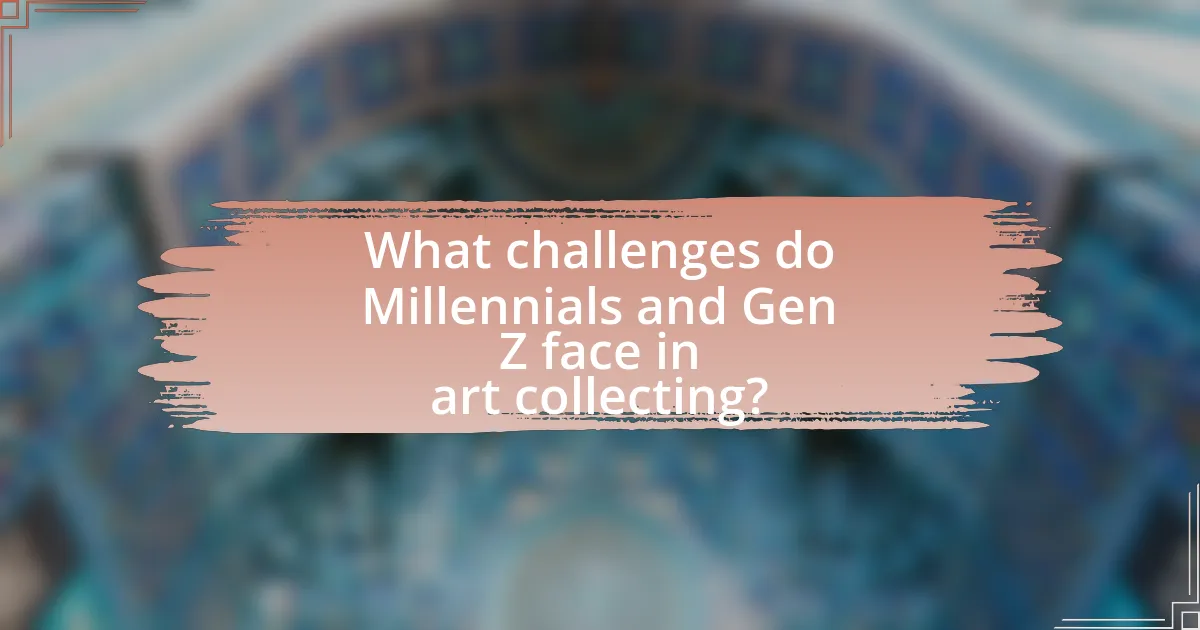
What challenges do Millennials and Gen Z face in art collecting?
Millennials and Gen Z face significant challenges in art collecting, primarily due to financial constraints and a lack of access to traditional art markets. Many individuals from these generations are burdened with student debt and high living costs, which limits their disposable income for art purchases. According to a 2021 survey by Art Basel and UBS, 60% of younger collectors cited affordability as a major barrier to acquiring art. Additionally, the traditional art market often feels exclusive and intimidating, making it difficult for these younger collectors to navigate and establish connections with galleries and artists. This combination of financial limitations and market accessibility issues creates substantial hurdles for Millennials and Gen Z in building their art collections.
What financial barriers exist for Millennials in the art market?
Millennials face several financial barriers in the art market, primarily due to high entry costs, student debt, and stagnant wages. The average price of contemporary art has significantly increased, with auction prices for emerging artists often exceeding $10,000, making it difficult for Millennials, who typically earn lower salaries compared to previous generations, to invest. Additionally, a report from the Federal Reserve indicates that Millennials carry an average student debt of $30,000, which limits their disposable income for art purchases. Furthermore, the economic impact of the COVID-19 pandemic has exacerbated financial instability, leading to reduced savings and investment capabilities among this demographic.
How do Millennials navigate the high costs of art acquisition?
Millennials navigate the high costs of art acquisition by leveraging technology and alternative purchasing methods. They increasingly utilize online platforms and social media to discover emerging artists and affordable artworks, often participating in crowdfunding initiatives or art subscription services that lower entry costs. According to a 2021 report by Hiscox, 63% of Millennial art buyers prefer online galleries, which provide access to a wider range of price points and styles compared to traditional galleries. Additionally, Millennials often prioritize investing in limited editions or prints, which are more budget-friendly than original pieces, allowing them to build their collections without incurring significant financial burdens.
What financing options are available for Millennial collectors?
Millennial collectors have several financing options available to them, including personal loans, credit cards, art financing companies, and crowdfunding platforms. Personal loans can provide a lump sum for purchasing art, while credit cards offer flexibility for smaller purchases. Art financing companies specialize in loans specifically for art acquisitions, often with favorable terms. Crowdfunding platforms allow collectors to raise funds from a community interested in supporting their art endeavors. These options cater to the financial needs of Millennials, who often seek accessible and innovative ways to build their collections.
What obstacles does Gen Z encounter when starting their art collections?
Gen Z encounters several obstacles when starting their art collections, primarily financial constraints, lack of access to traditional art markets, and limited knowledge about art investment. Financially, many Gen Z individuals are still in school or early in their careers, making it challenging to allocate funds for art purchases. Additionally, traditional art markets often cater to established collectors, leaving younger collectors with fewer opportunities to engage. Furthermore, a lack of education and resources about art valuation and investment strategies can hinder Gen Z’s ability to make informed purchasing decisions. These factors collectively create significant barriers for Gen Z in the art collecting landscape.
How does the lack of traditional art education affect Gen Z collectors?
The lack of traditional art education significantly impacts Gen Z collectors by limiting their understanding of art history and critical analysis skills. This gap in education often leads to a reliance on digital platforms and social media for art appreciation, which can result in a superficial engagement with art. According to a survey by Art Basel and UBS, 70% of Gen Z collectors primarily discover art through online channels, indicating a shift away from traditional learning environments. This reliance on digital sources may hinder their ability to evaluate art beyond trends, affecting their long-term collecting strategies and investment decisions.
What resources can Gen Z utilize to overcome these challenges?
Gen Z can utilize online platforms, educational resources, and community networks to overcome challenges in art collecting. Online platforms such as social media and digital marketplaces provide access to diverse art forms and artists, enabling Gen Z to discover and purchase art easily. Educational resources, including webinars and online courses, offer insights into art valuation, investment strategies, and market trends, equipping Gen Z with knowledge to make informed decisions. Community networks, such as local art collectives and online forums, foster collaboration and mentorship, allowing Gen Z to connect with experienced collectors and artists, thereby enhancing their understanding and appreciation of art.
How can both generations adapt to the evolving art market?
Both Millennials and Gen Z can adapt to the evolving art market by embracing digital platforms and innovative technologies. Millennials, who are already familiar with online art sales, can enhance their engagement by utilizing social media for promotion and community building. Gen Z, being digital natives, can leverage emerging technologies like augmented reality and blockchain to explore and purchase art in new ways. The rise of online art marketplaces, which saw a 70% increase in sales during the pandemic, demonstrates the shift towards digital engagement, making it essential for both generations to stay informed about these trends and actively participate in online art communities.
What strategies can Millennials employ to enhance their collections?
Millennials can enhance their collections by leveraging digital platforms for research, networking, and purchasing. Utilizing online marketplaces and social media allows them to discover emerging artists and trends, which can lead to unique acquisitions. According to a 2021 report by Art Basel and UBS, 63% of Millennials engage with art through online channels, highlighting the importance of digital engagement in modern collecting. Additionally, participating in art fairs and community events fosters connections with other collectors and artists, enriching their collection experience.
How can Gen Z leverage technology to build their art portfolios?
Gen Z can leverage technology to build their art portfolios by utilizing digital platforms and tools that facilitate creation, sharing, and networking. For instance, they can use social media platforms like Instagram and TikTok to showcase their artwork, reaching a global audience and attracting potential buyers or collaborators. Additionally, online portfolio websites such as Behance and ArtStation allow artists to present their work professionally and connect with other creatives.
Moreover, Gen Z can take advantage of digital art tools like Procreate and Adobe Creative Suite, which enable them to create high-quality digital art efficiently. According to a 2021 survey by Art Basel and UBS, 63% of young collectors are more likely to purchase art online, highlighting the importance of an online presence for artists. By integrating these technologies, Gen Z can effectively enhance their visibility and opportunities in the art world.
What best practices can Millennials and Gen Z follow for successful art collecting?
Millennials and Gen Z can follow several best practices for successful art collecting, including researching artists and their work, setting a budget, and focusing on personal taste. Researching artists helps collectors understand the market value and significance of the artwork, while setting a budget ensures financial responsibility. Focusing on personal taste allows collectors to build a meaningful collection that resonates with them. According to a 2021 report by Art Basel and UBS, 63% of young collectors prioritize personal enjoyment over investment potential, highlighting the importance of passion in art collecting.
